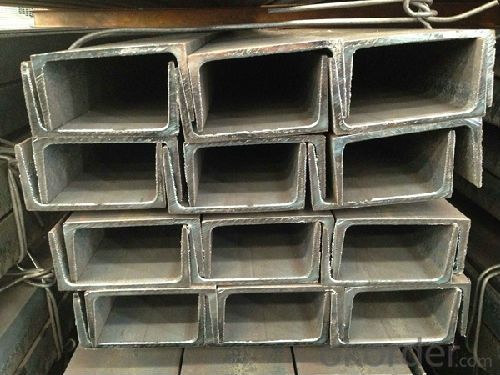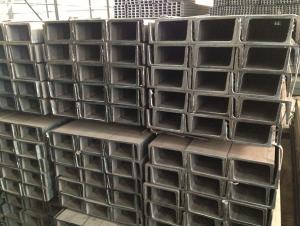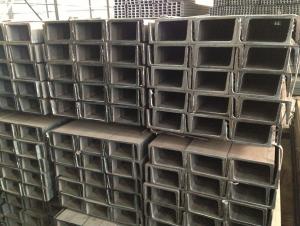GB Steel Channel Q235 With High Quality
- Loading Port:
- China main port
- Payment Terms:
- TT or LC
- Min Order Qty:
- 25 m.t
- Supply Capability:
- 2000 m.t/month
OKorder Service Pledge
OKorder Financial Service
You Might Also Like
Product Applications:
GB Steel Channel Q235 With High Quality re ideal for structural applications and are widely used in the construction of buildings and bridges, and the manufacturing, petrochemical, and transportation industries.
Product Advantages:
OKorder's GB Steel Channel Q235 With High Quality are durable, strong, and resist corrosion.
Main Product Features:
· Premium quality
· Prompt delivery & seaworthy packing (30 days after receiving deposit)
· Corrosion resistance
· Can be recycled and reused
· Mill test certification
· Professional Service
· Competitive pricing
The steel u channel will be packed in bundle with steel wire at each end of every bundle and color marking in order to help the customer to recognize his goods more easily at sight.
And steel u channel could be loaded into 20ft or 40ft container, or by bulk cargo. If the weight of each bundle reaches less than 3.5 mt, the loading by break bulk cargo should be choosed. When the weight of each bundle reaches less than 3mt, the loading by container should be choosed.
As for the transportaion from mill to loading port, the truck will be usually used. And the maximum quantity for each truck is 40mt.
All in all, we could do in accordance with customer's request.
Trade terms: FOB, CFR, CIF
FAQ:
Q1: Why buy Materials & Equipment from OKorder.com?
A1: All products offered byOKorder.com are carefully selected from China's most reliable manufacturing enterprises. Through its ISO certifications, OKorder.com adheres to the highest standards and a commitment to supply chain safety and customer satisfaction.
Q2: How do we guarantee the quality of our products?
A2: We have established an advanced quality management system which conducts strict quality tests at every step, from raw materials to the final product. At the same time, we provide extensive follow-up service assurances as required.
Q3: How soon can we receive the product after purchase?
A3: Within three days of placing an order, we will begin production. The specific shipping date is dependent upon international and government factors, but is typically 7 to 10 workdays.
Images:


- Q:Can steel channels be used for supporting heavy machinery?
- Steel channels, with their flat base and two perpendicular sides, are well-suited for supporting heavy machinery. These durable components, made from steel, possess exceptional strength, making them an ideal option for providing the necessary support. Their unique shape not only enables excellent load-bearing capabilities but also ensures structural stability. Moreover, steel channels offer the convenience of being easily welded or bolted together, allowing for the creation of a customized support structure capable of withstanding the weight and vibrations produced by heavy machinery. Overall, steel channels are a dependable and widely used choice, thanks to their strength, versatility, and ability to withstand heavy loads.
- Q:Can steel channels be used in the construction of elevated walkways?
- Indeed, elevated walkways can be constructed using steel channels. C-channels, which are an alternative name for steel channels, are frequently utilized in construction owing to their robustness and longevity. They are apt for bearing substantial loads and can be engineered to ensure the essential structural stability for elevated walkways. Steel channels possess exceptional resistance against bending and twisting forces, rendering them perfect for establishing secure and steady walkways situated at great heights. Furthermore, steel channels can be conveniently fabricated and installed, facilitating the efficient construction of elevated walkways. All in all, steel channels are a dependable and popular option when it comes to the construction of elevated walkways.
- Q:Are steel channels suitable for seismic zones?
- Yes, steel channels are suitable for seismic zones. Steel is a strong and ductile material that can effectively resist seismic forces. Steel channels are commonly used in seismic design and construction due to their ability to provide structural stability and resilience during earthquakes. They offer excellent strength-to-weight ratio, flexibility, and resistance to bending and shearing forces, making them a reliable choice for seismic zone applications.
- Q:What are the different load distribution techniques for steel channels in roof systems?
- Steel channels in roof systems can benefit from various load distribution techniques. These techniques play a crucial role in evenly distributing weight and forces on the channels, thus minimizing the chances of structural failure. One effective technique involves utilizing purlins, which are horizontal beams placed on top of the steel channels. These purlins offer additional support and aid in achieving a more uniform load distribution. Depending on the specific requirements of the roof system, purlins can be made from steel, wood, or other suitable materials. Another method is bridging, which entails installing vertical or diagonal braces between the steel channels. This prevents twisting or buckling under heavy loads and spreads the load over multiple channels. By doing so, the overall strength and stability of the channels are significantly enhanced. Furthermore, the spacing between the steel channels themselves plays a crucial role in load distribution. Increasing the spacing between the channels can contribute to a more even distribution of weight, reducing the concentration of load on individual channels. However, it is essential to adhere to recommended spacing guidelines to maintain the structural integrity of the system. Moreover, load-bearing walls or columns can also contribute to load distribution in roof systems. These elements provide additional support at specific points along the channels, effectively distributing the load and preventing excessive stress on individual channels. To summarize, load distribution techniques for steel channels in roof systems encompass the use of purlins, bridging, proper channel spacing, and the incorporation of load-bearing elements. These techniques work in unison to ensure an even distribution of weight and forces on the channels, minimizing the risk of structural failure and ensuring the long-term durability of the roof system.
- Q:How do steel channels contribute to earthquake resistance in buildings?
- There are multiple ways in which steel channels contribute to the earthquake resistance of buildings. To begin with, steel channels are commonly utilized as structural elements within building frames. They provide the necessary strength and rigidity to the overall structure, effectively countering the lateral forces that arise during earthquakes. These lateral forces, often referred to as seismic forces, have the potential to cause buildings to sway and deform. By implementing steel channels, the building's frame gains increased resistance to these forces, reducing the likelihood of collapse. Furthermore, steel channels can be strategically positioned in key areas of the building to enhance its seismic performance. For instance, they can be employed as braces or shear walls to offer additional support and stability. Bracing systems composed of steel channels aid in the distribution of seismic forces throughout the structure, preventing the concentration of stress points and improving the overall integrity of the building. Moreover, steel channels can be integrated into the building's foundation to enhance its ability to withstand ground motion during an earthquake. By connecting the foundation to the superstructure using steel channels, the building becomes more adept at absorbing and dissipating seismic energy. Consequently, this minimizes the transmission of forces to the building, thereby reducing the potential for damage. In addition, steel channels possess an attribute known as ductility, which is crucial for earthquake resistance. Ductility refers to a material's capacity to deform without breaking. During an earthquake, buildings experience substantial stress and deformation. Steel channels have the ability to absorb this energy and deform without compromising their structural integrity. This ductile behavior prevents sudden failure and allows the building to undergo controlled deformation, ultimately enhancing its seismic performance. In conclusion, the incorporation of steel channels into building design and construction plays a vital role in enhancing earthquake resistance. The strength, rigidity, strategic placement, integration into the foundation, and ductility offered by steel channels all contribute to improving the structural integrity and resilience of buildings during seismic events. By incorporating steel channels, the risk of collapse and damage resulting from earthquakes can be significantly reduced.
- Q:Can steel channels be used for balcony railings?
- Yes, steel channels can be used for balcony railings. Steel channels are commonly used in construction for their strength and durability, making them suitable for supporting and securing balcony railings.
- Q:Can steel channels be used in modular data centers?
- Absolutely, modular data centers can make use of steel channels. Steel channels find wide application in construction, particularly in providing structural support and reinforcement, and this holds true for modular data centers as well. Their exceptional strength and durability make them an ideal choice for supporting heavy equipment and infrastructure within data center facilities. Steel channels can effectively frame server racks, cable trays, and other equipment mounting structures, guaranteeing stability and security within the modular data center. Moreover, steel channels can be effortlessly tailored and fabricated to meet specific design specifications, seamlessly integrating into the overall construction of the modular data center.
- Q:What is the difference between U steel and channel steel?
- Channel steels and U steels are simply different when applied,Mainly divided into ordinary channel (U steel) and light channel (light U steel).It can also be considered as follows: the channel steel is formed by thermal elongation, and the U steel is generally rolled under cold condition.The biggest difference between the two is thickness: the overall thickness of the channel is not the same, the overall thickness of light U steel is the same
- Q:How much is the load-bearing capacity of No. 10 I-beam per metre?
- National Standard No. 10 I-beam is 11.261kg/ meters; 6 meters long weight is 67.566kg
- Q:How do steel channels contribute to the stability of cantilevered structures?
- There are several ways in which steel channels contribute to the stability of cantilevered structures. Firstly, their high strength and durability make them ideal for supporting heavy loads and resisting external forces. When used as a structural component in cantilevered structures, they provide the necessary support and stability to counteract the bending moments and shear forces that act on the structure. In addition, the U-shaped cross-section of steel channels enhances their load-bearing capacity and resistance to bending. This shape allows for a more efficient distribution of forces, preventing excessive deflection and ensuring the structural integrity of the cantilever. Steel channels are also commonly used in combination with other structural elements, such as beams and columns, to create a rigid framework. This framework provides additional support and stiffness to the cantilevered structure, preventing any excessive movement or deformation. Moreover, the versatility of steel channels allows for various configurations and connections, enabling engineers to design cantilevered structures with different shapes and sizes to meet specific requirements. This adaptability ensures that the structure can withstand different loads and environmental conditions, enhancing its overall stability. Finally, steel channels can be precisely fabricated, ensuring accurate alignment and assembly during construction. This precision minimizes any potential weak points or gaps in the structure, further enhancing its stability and safety. In conclusion, steel channels significantly contribute to the stability of cantilevered structures by providing high strength, load-bearing capacity, and resistance to bending. Their U-shaped cross-section, versatility, and precise fabrication also play crucial roles in ensuring the overall stability and integrity of these structures.
1. Manufacturer Overview |
|
|---|---|
| Location | |
| Year Established | |
| Annual Output Value | |
| Main Markets | |
| Company Certifications | |
2. Manufacturer Certificates |
|
|---|---|
| a) Certification Name | |
| Range | |
| Reference | |
| Validity Period | |
3. Manufacturer Capability |
|
|---|---|
| a)Trade Capacity | |
| Nearest Port | |
| Export Percentage | |
| No.of Employees in Trade Department | |
| Language Spoken: | |
| b)Factory Information | |
| Factory Size: | |
| No. of Production Lines | |
| Contract Manufacturing | |
| Product Price Range | |
Send your message to us
GB Steel Channel Q235 With High Quality
- Loading Port:
- China main port
- Payment Terms:
- TT or LC
- Min Order Qty:
- 25 m.t
- Supply Capability:
- 2000 m.t/month
OKorder Service Pledge
OKorder Financial Service
Similar products
New products
Hot products
Related keywords




























